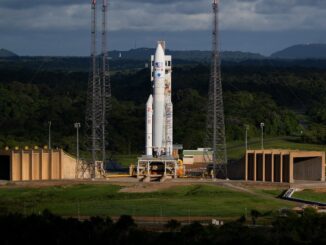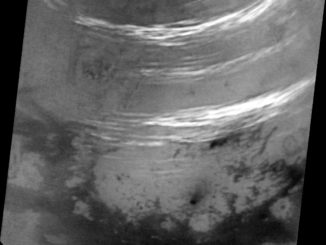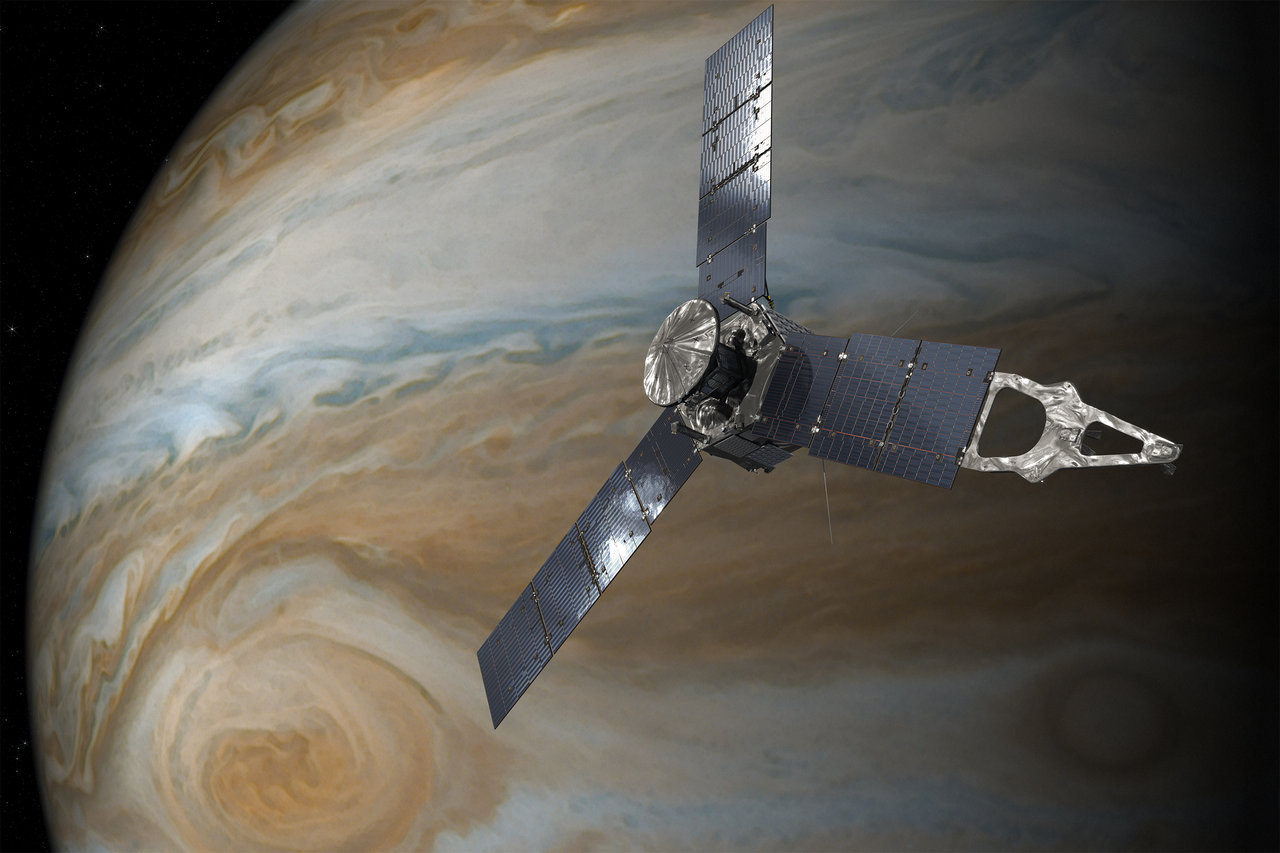
Four days out from arriving at the solar system’s biggest planet, NASA’s Juno spacecraft received a final uplink of commands Thursday governing the robotic probe’s high-velocity braking maneuver Monday to steer into orbit around Jupiter.
Juno will run on autopilot for the rest of its approach, counting down to a series of tightly-choreographed maneuvers Monday leading to ignition of the craft’s main engine to slow its speed by 1,212 mph (541.7 meters per second), just enough to be captured in orbit by the firm grasp of Jupiter’s gravity.
Before uploading the final command sequence, ground controllers stationed at NASA’s Jet Propulsion Laboratory and at a control center run by Lockheed Martin, the spacecraft’s builder and operator, prepared the engine for Monday’s critical burn.
“Ten days ago, we opened the main engine cover so that the engine would be ready to fire when we get to July 4, and a couple of days ago we pressurized the whole system, so that the engine is ready to go, (and) all the propulsion, all the pipes and valves are all ready to fire,” said Ed Hirst, Juno mission manager at JPL.
Engineers transmitted the final command file, dubbed “ji4040,” to Juno around 3:15 p.m. EDT (1915 GMT) Thursday via an antenna in NASA’s Deep Space Network located in Goldstone, California.
“Once those commands are sent, it will be hands-off from the team here on the ground,” Hirst told reporters Thursday before sending the order for Juno to launch its Jupiter arrival sequence. “We’ll continue to monitor the spacecraft and make sure everything is executing as we expect it to execute, but the spacecraft is on its own, and it’s designed to take care of itself with all the command sequences that we’ve sent it.”
Scott Bolton, an astrophysicist from the Southwest Research Institute in San Antonio who leads the Juno science team, said Thursday he has mixed emotions as the spacecraft zips toward Jupiter on the tail end of a 1.7 billion-mile (2.8 billion-kilometer) journey.
“Yeah, I’m nervous,” Bolton said.
Bolton’s team proposed the $1.1 billion Juno mission to NASA in February 2004, and it beat out a competing concept to return samples from South Pole-Aitken basin on the far side of the moon, winning the space agency’s backing in June 2005.
Juno launched Aug. 5, 2011, from Cape Canaveral on top of the most powerful version of United Launch Alliance’s Atlas 5 rocket, and the probe returned to Earth’s vicinity in October 2013 for a gravity assist, slingshotting it toward Jupiter.
“I’m excited with anticipation, of course, because we’re finally arriving, but I also have tension and nervousness because there’s a lot riding on what happens July 4,” Bolton said.
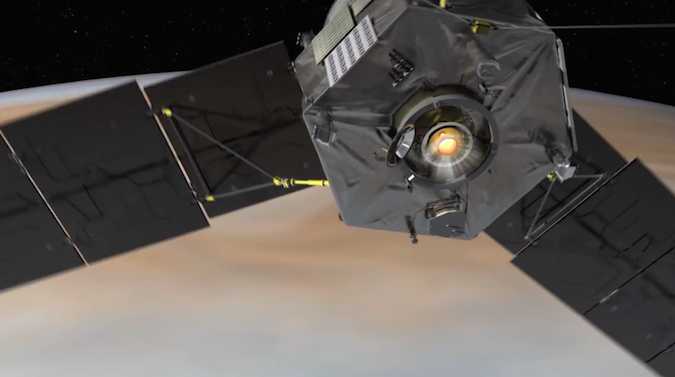
Engineers expect to receive confirmation that Juno’s main engine, burning a mix of liquid hydrazine and nitrogen tetroxide propellants, has started its 35-minute burn at 11:18 p.m. EDT Monday (0318 GMT Tuesday).
Radio tones broadcast by Juno will be picked up by an array of huge dish antennas on the ground. Each tone comes in at a slightly different frequency, indicating when Juno accomplishes one of the many steps during the arrival sequence.
Juno’s high-gain antenna will not be pointed toward Earth during the insertion burn, eliminating any chance engineers will receive detailed telemetry on the progress of the engine firing.
Instead, controllers will listen for tones at the start and end of the burn, and watch for a subtle fluctuation in the radio signal coming from Juno caused by the Doppler shift, a variation in the frequency of the spacecraft’s transmission as its velocity changes.
The Doppler effect is similar to the change in pitch of an emergency siren as an ambulance passes.
Heading for a point 2,900 miles (4,667 kilometers) above Jupiter, Juno will configure itself for the make-or-break engine firing beginning shortly after 9 p.m. EDT Monday (0100 GMT Tuesday), when the spacecraft will begin turning to face the right direction for the burn.
The pointing maneuver will turn Juno’s three huge solar array wings, each stretching nearly 30 feet (9 meters) long, away from the sun, forcing the probe to drain power from its batteries. Juno is the first spacecraft to travel to Jupiter’s distance, where the sun is 25 times dimmer than it is at Earth, and rely solely on solar power.
Built with lean power requirements in mind, the power-efficient space probe can run all its systems and scientific instruments on enough juice to power five 100-watt light bulbs.
About 22 minutes before ignition, Juno’s smaller pointing thrusters will increase the craft’s spin rate from 2 rpm to 5 rpm for added stability during the main engine burn.
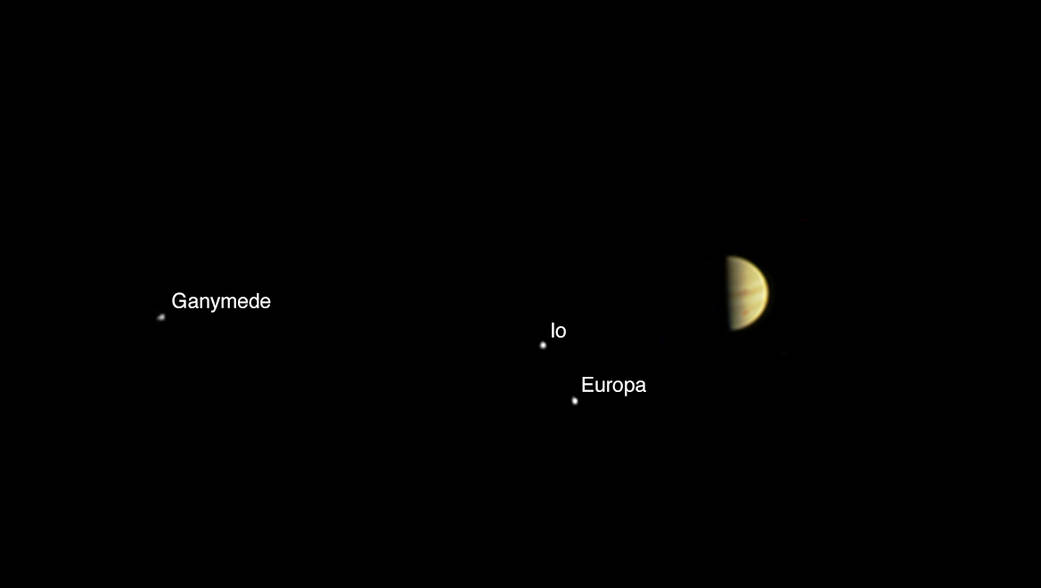
At the time of Juno’s engine firing, Jupiter’s gravity will exert a tight tug on the spacecraft, accelerating it to approximately 150,000 mph (about 250,000 kilometers per hour), making Juno one of the fastest human-made objects in history.
Soon after the insertion maneuver is complete, Juno will spin down back to its standard two revolutions per minute, then turn back toward the sun to start recharging its batteries and beam telemetry to engineers on Earth.
Check out a detailed timeline of the major events Monday.
Juno’s Leros 1b engine, supplied by Moog-ISP in the United Kingdom, needs to fire for at least 20 minutes for the probe to reach a safe orbit around Jupiter, according to Rick Nybakken, the mission’s project manager at JPL.
Otherwise, Jupiter’s gravity will bend Juno’s trajectory and send it speeding back into interplanetary space, missing the planet entirely.
Software programmers installed safeguards to raise the probability of a good insertion burn, including an “auto restart” feature to allow the engine to quickly resume the burn if a computer fault or another anomaly interrupts it.
Monday’s engine burn, assuming it operates for all 35 minutes, will place Juno in an elongated orbit that takes the spacecraft around Jupiter’s poles once every 53-and-a-half days. A follow-up engine burn is scheduled for Oct. 19 to lower the high end of Juno’s orbit, placing the robot on a course around the planet that takes it as close as 3,100 miles (5,000 kilometers) over Jupiter’s cloud tops every two weeks.
During each close flyby of Jupiter, the body-mounted instruments aboard Juno will take turns looking at the planet’s clouds, measuring plasma, and quantifying the giant world’s gravitational and magnetic fields as the orbiter spins on its axis once every 30 seconds.
Ground controllers powered off Juno’s extensive science payload Thursday ahead of the July 4 arrival, but the instruments detected the probe’s crossing into the Jovian magnetosphere last week, registering a change in the environment around the spacecraft as it moved out of the solar wind and into a region dominated by Jupiter.
The sensors will be turned back on July 6 once Juno is safely in orbit, then scientists will prepare the mission’s instrument package for the orbiter’s first dive close to Jupiter on Aug. 27. Managers will treat that close-up approach, or perijove, as a rehearsal for later orbits after Juno begins full science operations in November, obtaining early data and images to help plan observations on future passes.
The mission top priorities are remotely probing inside Jupiter to determine whether the planet harbors a solid, rocky core, and measuring the amount of water held inside the gaseous world. Those clues could help scientists determine how and where Jupiter formed, and lead researchers to know more about the origins of the rest of the planets, and even life itself.
Juno is going into the most extreme environment ever visited by a spacecraft. An intense magnetic field and deadly radiation await Juno, hazards that threaten to fry the probe’s sensitive electronics. Engineers crammed Juno’s most critical computer gear inside a titanium vault to shield against the worst of Jupiter, but there are still risks.
NASA says Juno will be exposed to 20 million rads during its time at Jupiter, equivalent to more than 100 million dental X-rays. Officials say the radiation will likely strain Juno’s health, limiting it to a lifetime of about 20 months from the time the craft gets to Jupiter.
The magnetic field at Juno’s position is an order of magnitude stronger than any space vehicle has ever experienced.
“This spacecraft is going to fly in space through a magnetic field that is 10 times greater than anything we’ve ever experienced,” said Jack Connerney, Juno’s deputy principal investigator and head of the mission’s magnetometer investigation. “That is one of the curiosities. We’re going to have to see how it performs when we do that.”
Email the author.
Follow Stephen Clark on Twitter: @StephenClark1.


